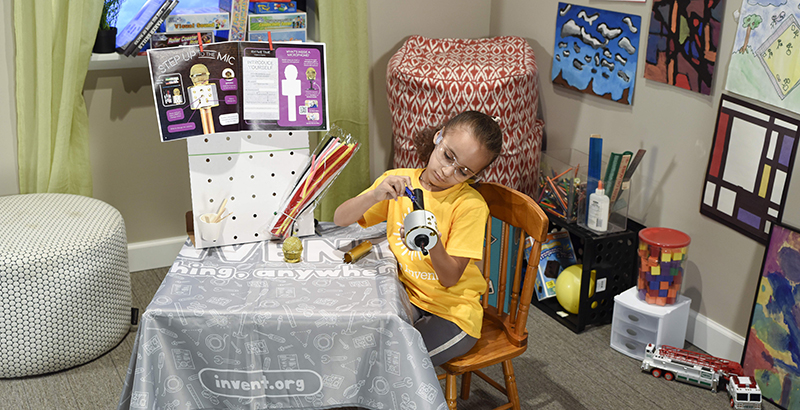Camp Invention Hands-on Summer STEM Program Goes Virtual, Bringing Creativity and Innovation to Kids — and Their Families

Get essential education news and commentary delivered straight to your inbox. Sign up here for The 74’s daily newsletter.
The National Inventors Hall of Fame’s Camp Invention program has gotten pretty, well, inventive with the way it delivers content during the pandemic. And that includes offering both in-person and virtual camps, connecting not only to K-8 students, but to entire families through the Camp Invention at Home program.
The hall of fame began in 1973 with a Virginia museum and has a strong emphasis on STEM-focused youth education, leveraging the insights of its annual honorees to create curriculum for in-classroom courses, after-school programs and summer camps in all 50 states. When the pandemic hit in spring 2020, the hall wanted to create online options for its 30-year-old Camp Invention, encouraging students to collaborate with other virtual campers or work with their own families.
“I think sometimes, with our parents with virtual school scenarios, it can be kind of stressful and intimidating when you’re trying to support your child with various subjects and homework and expectations,” says Jayme Cellitioci, creativity and innovation strategist for the hall of fame. “I think these out-of-school-time STEM experiences, like Camp Invention, give you more of the positive side of the experience where you can take more risks and engage with your child in a more playful way where everyone is learning and building their confidence.”
Over 132,000 students have participated in Camp Invention this summer, with the majority selecting an in-person camp and others opting for a $235 week-long virtual experience. At-home students, grouped by region and age, receive kits with all necessary materials for building a series of inventions. Daily activities include a live kickoff with an instructor leading the day’s module and collaboration with other students as they socialize and experiment with their inventions, such as a device to explore trajectory and velocity; a vehicle that can “submerge, soar or sprint”; or a solar-powered robotic cricket. If families can’t make the live feed, they can watch step-by-step instructional videos. Staff also designed an unplugged version that doesn’t require a computer.
Nayana Mallikarjuna, a Dallas parent whose son Rohan attended Camp Invention at Home, says there weren’t a lot of online options that could engage her son for more than four hours. “In a virtual setting, it was nice to see kids have an opportunity to interact with each other and share what they’ve built,” she says. “It was a great way to help him socialize virtually while learning and being engaged virtually.”
The hall creates camps completely new each year, using inductees both as inspiration and part of the curriculum. For example, a recent program called Open Mic, run both in person and virtually, includes a Zoom lesson with Jim West, inventor of the electric microphone. In the Open Mic program, kids use materials in the provided kit to explore the inside of a microphone, then create their own hands-on invention and end up with a wireless microphone with a recorded message from West. “Not only are we taking some of their inspiration and insight,” Cellitioci says of the inductees, “sometimes we are drilling into the details of programs with them.”
Another popular at-home offering is a line-tracing robot, allowing students to turn their entire home into a robot laboratory with an Optibot that uses sensors to travel on lines that the kids draw on paper.
The hall wanted the At Home version to feel like an immersive camp-like environment, so the kit that participants receive includes a maker mat, a blanket-like work surface; a toolbelt with equipment, from markers to screwdrivers, for creating their inventions; a pegboard for hanging extra parts and materials; and inventor logs, a workbook and journal where kids can track their ideas and progress.
With the hands-on aspect of activities such a critical part of a camp experience, Cellitioci says, the hall of fame needed to rethink the way the camps were packaged to keep the focus on real-life inventing, with the computer used only as a communication tool.
The goal was to give kids a successful camp experience without parental involvement, but also welcome families. “We saw this as a really nice chance to hold our parents’ hands in empowering them to join the learning process as they are able to and potentially build some of their own STEM confidence,” Cellitioci says. “We have gotten really wonderful feedback from our families and we have seen that parents have loved getting a behind-the-scenes look at this. It encourages them to feel more confident regardless of their knowledge and experience of STEM so they can become facilitators of these learning experiences.”
Jessica Stephenson, a parent in Wadsworth, Ohio, says Camp Invention At Home provided a collaborative, high-energy opportunity for her children, Lauren and Zander, to immerse themselves in a STEM experience when fun was otherwise canceled.
“Both of my kids have extra needs that would normally be a challenge during an in-person camp,” she says. “Being able to log in from the comfort of our home allowed us to have a little more control of different sensory issues that might pop up during an in-person program.” The setting gave her kids confidence to interact with other students and the instructor while sharing their inventions.
“Lauren and Zander loved hands-on activities that stretched their thinking far beyond their normal limits,” she says. “Lauren … was so proud that she created inventions, and Zander loved that he was able to use his hands — and items from his toolbelt — to build projects to help the environment.”
Mallikarjuna says her son had been to the in-person Camp Invention in the past, so the virtual option helped him “unleash his imagination and creativity” while experiencing a sense of achievement. “Being a working mom, I wanted my son to be engaged and, at the same time, enjoy learning and interacting with other kids, virtually,” she says. “It was fun and innovative.”
The at-home program continues through August, with week-long virtual camps still open the weeks of Aug. 9, 16 and 23. Parents can search for in-person camps or connect with their kids for a virtual experience, as seats are still open those final three weeks of the schedule.
Going forward, virtual experiences “will in some fashion likely stay as part of our mix,” Cellitioci says. “I would say it has forever expanded our capacity and opened our eyes to new opportunities.”
Get stories like these delivered straight to your inbox. Sign up for The 74 Newsletter

;)
